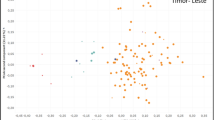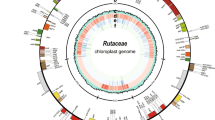Abstract
Craigia yunnanensis (Tiliaceae) is an endangered relic tree in China. Its wild populations have been seriously damaged and fragmented due to severe human disturbance. In this study, we developed microsatellite markers in order to study the variation of the mating system of C. yunnanensis. We collected 19 067 214 unigenes sequences by shallow sequencing of the genome. A bioinformatics screening identified 15 235 unique and putative microsatellites, from which 590 novel microsatellite markers were developed. We designed 70 primer pairs and successfully amplified 14 of them in 30 individuals. The number of alleles per locus ranged from 1 to 12. The observed and expected heterozygosities ranged from 0.000 to 1.000 and 0.000 to 0.906, respectively. These microsatellite loci will enrich the genetic resources to develop functional studies and conservation strategies for this endangered relict species.
Similar content being viewed by others
REFERENCES
Kvaček, Z., Manchester, S.R., Zetter, R., and Pingen, M., Fruits and seeds of Craigia bronnii (Malvaceae—Tilioideae) and associated flower buds from the late Miocene Inden formation, lower Rhine basin, Germany, Rev. Palaeobot. Palynol., 2002, vol. 119, nos. 3–4, pp. 311–324.
Jin, J.H., Kodrul, T.M., Liao, W.B., and Wang, X., A new species of Craigia from the Eocene Changchang formation of Hainan Island, China, Rev. Palaeobot. Palynol., 2009, vol. 155, nos. 1–2, pp. 80–82.
Qin, H.N., Yang, Y., and Dong, S.Y., et al. Threatened species list of China’s higher plants, Biodiversity Sci., 2017, vol. 25, no. 7, pp. 696–744.
Gao, Z.R., Zhang, C.Q. and Milne, R.L., Size-class structure and variation in seed and seedling traits in relation to population size of an endangered species Craigia yunnanensis (Tiliaceae), Aust. J. Bot., 2010, vol. 58, no. 3, pp. 214–223.
Yang, J., Gao, Z.R., Sun, W.B., and Zhang, C.Q., High regional genetic differentiation of an endangered relict plant Craigia yunnanensis and implications for its conservation, Plant Diversity, 2016, vol. 38, no. 5, pp. 221–226.
Ashley, M.V. and Dow, B.D., The use of microsatellite analysis in population biology: background methods and potential applications, Exs, 1994, vol. 69, no. 69, pp. 185–201.
Dawson, I.K., Waugh, R., Simons, A.J., and Powell, W., Simple sequence repeats provide a direct estimate of pollen-mediated gene dispersal in the tropical tree Gliricidia sepium,Mol. Ecol., 2003, vol. 6, no. 2, pp. 179–183.
Yang, J., Zhao, L.L., Yang, J.B., and Sun, W.B., Genetic diversity and conservation evaluation of a critically endangered endemic maple, Acer yangbiense, analyzed using microsatellite markers, Biochem. System. Ecol., 2015, vol. 60, pp. 193–198.
Liu, J. and Gao, L.M., Comparative analysis of three different methods of total DNA extraction used in Taxus,Guihaia, 2011, vol. 31, no. 2, pp. 244–238.
Meglécz, E., Costedoat, C., and Dubut, V., et al., QDD: a user-friendly program to select microsatellite markers and design primers from large sequencing projects, Bioinformatics, 2010, vol. 26, no. 3, pp. 403–404.
PeaKall, R. and Smouse, P.E., GenAlEx 6.5: genetic analysis in Excel. Population genetic software for teaching and research: an update, Bioinformatics, 2012, vol. 28, pp. 2537–2539.
Kalinowski, S.T., Taper, M.L., and Marshall, T.C., Revising how the computer program Cervus, accommodates genotyping error increases success in paternity assignment, Mol. Ecol., 2010, vol. 16, no. 5, pp. 1099–1106.
Funding
The study was conducted at the Germplasm Bank of Wild Species in Southwest China, Kunming Institute of Botany, Chinese Academy of Sciences. This work was supported by the National Natural Science Foundation of China (Grants no. 31600439), National Key R&D Program of China (2017YFC0505200) and Key Laboratory Construction of Yunnan Science and Technology Talents and Platform Program (Grant no. 2018DG004).
Author information
Authors and Affiliations
Corresponding authors
Ethics declarations
The authors declare that they have no conflict of interest. This article does not contain any studies involving animals or human participants performed by any of the authors.
Rights and permissions
About this article
Cite this article
Chen, Y.L., Yang, J. & Sun, W.B. Development of 14 Microsatellite Markers in the Endangered Relict Plant Craigia yunnanensis (Tiliaceae). Russ J Genet 56, 123–127 (2020). https://doi.org/10.1134/S1022795420010032
Received:
Revised:
Accepted:
Published:
Issue Date:
DOI: https://doi.org/10.1134/S1022795420010032




